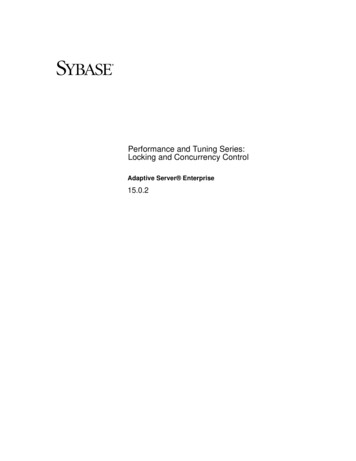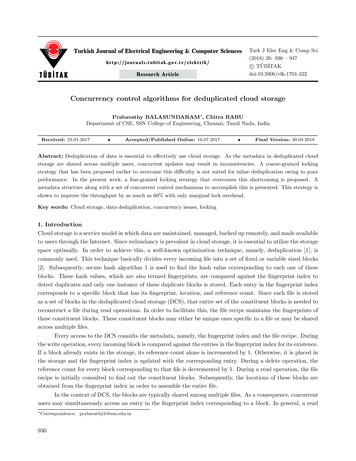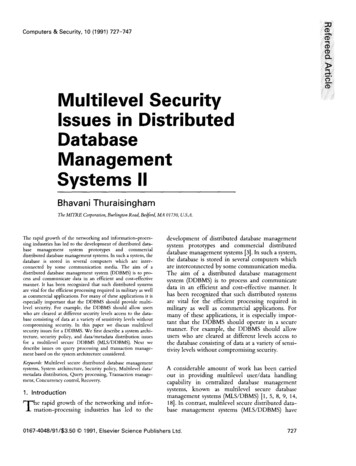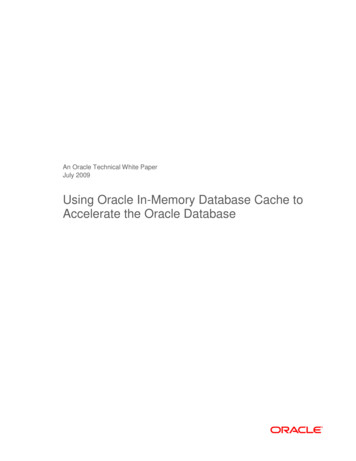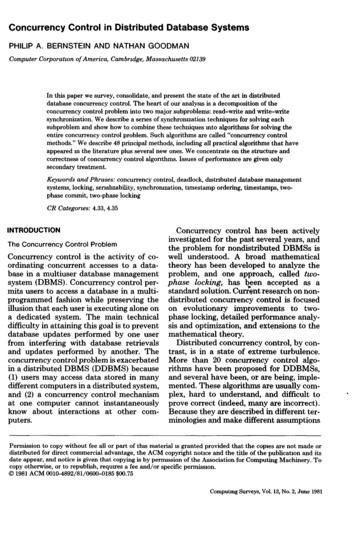
Transcription
Concurrency Control in Distributed Database SystemsPHILIP A. BERNSTEIN AND NATHAN GOODMANComputer Corporation of America, Cambridge, Massachusetts 02139In this paper we survey, consolidate, and present the state of the art in distributeddatabase concurrency control. The heart of our analysts is a decomposition of theconcurrency control problem into two major subproblems: read-write and write-writesynchronization. We describe a series of synchromzation techniques for solving eachsubproblem and show how to combine these techniques into algorithms for solving theentire concurrency control problem. Such algorithms are called "concurrency controlmethods." We describe 48 principal methods, including all practical algorithms that haveappeared m the literature plus several new ones. We concentrate on the structure andcorrectness of concurrency control algorithms. Issues of performance are given onlysecondary treatment.Keywords and Phrases: concurrency control, deadlock, dtstnbuted database managementsystems, locking, senahzability, synchromzation, tunestamp ordering, timestamps, twophase commit, two-phase lockingCR Categories: 4.33, 4.35INTRODUCTIONThe Concurrency Control ProblemC o n c u r r e n c y control is the activity of coordinating concurrent accesses to a database in a multiuser d a t a b a s e m a n a g e m e n ts y s t e m (DBMS). C o n c u r r e n c y control permits users to access a d a t a b a s e in a multip r o g r a m m e d fashion while preserving theillusion t h a t each user is executing alone ona dedicated system. T h e m a i n technicaldifficulty in attaining this goal is to p r e v e n td a t a b a s e u p d a t e s p e r f o r m e d b y one userf r o m interfering with d a t a b a s e retrievalsand u p d a t e s p e r f o r m e d b y another. T h econcurrency control p r o b l e m is e x a c e r b a t e din a distributed D B M S ( D D B M S ) because(1) users m a y access d a t a stored in m a n ydifferent c o m p u t e r s in a distributed system,and (2) a concurrency control m e c h a n i s mat one c o m p u t e r cannot instantaneouslyknow a b o u t interactions at o t h e r computers.C o n c u r r e n c y control h a s b e e n activelyinvestigated for the p a s t several years, a n dthe p r o b l e m for n o n d i s t r i b u t e d D B M S s iswell understood. A b r o a d m a t h e m a t i c a lt h e o r y h a s b e e n developed to analyze theproblem, a n d one a p p r o a c h , called twop h a s e locking, h a s b e e n a c c e p t e d as as t a n d a r d solution. Curre.nt r e s e a r c h on nondistributed c o n c u n ' e n c y control is focusedon evolutionary i m p r o v e m e n t s to twop h a s e locking, detailed p e r f o r m a n c e analysis and optimization, a n d extensions to them a t h e m a t i c a l theory.D i s t r i b u t e d concurrency control, b y contrast, is in a s t a t e of e x t r e m e turbulence.M o r e than 20 concurrency control algorithms have been proposed for D D B M S s ,and several have been, or are being, implemented. T h e s e algorithms are usually complex, hard to understand, a n d difficult toprove correct (indeed, m a n y are incorrect).Because they are described in different terminologies a n d m a k e different assumptionsPermission to copy without fee allor part of thismaterialm granted provided that the coplesare not made ordistributedfor directcommercial advantage, the A C M copyrightnotice and the titleof the publicationand itsdate appear, and noticeis given that copying isby perrmssion of the Associationfor Computing Machinery. Tocopy otherwise,or to republish,requiresa fee and/or specificpermission. 1981 ACM 0010-4892/81/0600-0185 00.75Computing Surveys, Vol. 13, No. 2, June 1981
186 P. A. Bernstein a n d N. GoodmanCONTENTSINTRODUCTIONThe Concurrency Control ProblemExamples of Concurrency Control AnomaliesComparison to Mutual Exclnslon Problems1. TRANSACTION-PROCESSING MODEL1.1 Prelmunary Defimtmns and DDBMS Architecture1.2 Centrahzed Transactmn-Processmg Model1.3 Dmmbuted Transactmn-Processing Model2 DECOMPOSITION OF THE CONCURRENCY CONTROL PROBLEM2 1 Selaallzabfllty2.2 A Parachgm for Concurrency Control3. SYNCHRONIZATION TECHNIQUESBASED ON TWO-PHASE LOCKING3.1 Basra 2PL Implementation3.2 Primary Copy 2PL3.3 Voting 2PL3.4 Centrahzed 2PL3.5 Deadlock Detection and Prevention4 SYNCHRONIZATION TECHNIQUESBASED ON TIMESTAMP ORDERING4.1 Basic T/O Implementatmn4.2 The Thomas Write Rule4.3 MulUversion T/O4.4 Conservative T/O4 5 Tnnestamp Management5 INTEGRATED CONCURRENCY CONTROLMETHODS5 1 Pure 2PL Methods5.2 Pure T/O Methods5.3 MLxed 2PL and T/O Methods6. CONCLUSIONAPPENDIX. OTHER CONCURRENCY CONTROL METHODSAI. CertifiersA2. Thomas' MaJority Consensus AlgorithmA3. Ellis' Ring AlgorithmACKNOWLEDGMENTREFERENCESvabout the underlying D D B M S environment, it is difficult to compare the manyproposed algorithms, even in qualitativeterms. Naturally each author proclaims hisor her approach as best, but there is littlecompelling evidence to support the claims.To survey the state of the art, we introduce a standard terminology for describingD D B M S concurrency control algorithmsand a standard model for the D D B M S environment. For analysis purposes we decompose the concurrency control probleminto two major subproblems, called readwrite and write-write synchronization. EvComputing Surveys, Vol. 13, No 2, June 1981cry concurrency control algorithm must include a subalgorithm to solve each subproblem. The first step toward understanding aconcurrency control algorithm is to isolatethe subalgorithm employed for each subproblem.After studying the large number of proposed algorithms, we find that they arecompositions of only a few subalgorithms.In fact, the subalgorithms used by all practical D D B M S concurrency control algorithms are variations of just two basic techniques: two-phase locking and timestampordering; thus the state of the art is farmore coherent than a review of the literature would seem to indicate.Examples of Concurrency Control AnomaliesThe goal of concurrency control is to prevent interference among users who are simultaneously accessing a database. Let usillustrate the problem by presenting two"canonical" examples of interuser interference. Both are examples of an on-lineelectronic funds transfer system accessedvia remote automated teller machines(ATMs). In response to customer requests,ATMs retrieve data from a database, perform computations, and store results backinto the database.Anomaly 1: Lost Updates. Suppose twocustomers simultaneously try to depositmoney into the same account. In the absence of concurrency control, these two activities could interfere (see Figure 1). Thetwo ATMs handling the two customerscould read the account balance at approximately the same time, compute new balances in parallel, and then store the newbalances back into the database. The neteffect is incorrect: although two customersdeposited money, the database only reflectsone activity; the other deposit is lost by thesystem.Anomaly 2: Inconsistent Retrievals.Suppose two customers simultaneously execute the following transactions.Customer 1: Move 1,000,000 from AcmeCorporation's savings account to its checking account.Customer 2: P r i n t Acme Corporation'stotal balance in savings andchecking.
Concurrency Control in Database SystemsDotoboseExecut,on of T IIREADbolonceAdd I,000,000 1,500,000 [187Execution of T2I, 00000 ]0,000eJ 2 500,000 ] Add 21000,000WRITE resultbock to dotobosebock to dotoboseFigure1. Lostupdate anomaly.In the absence of concurrency controlthese two transactions could interfere (seeFigure 2). The first transaction might readthe savings account balance, subtract 1,000,000, and store the result back in thedatabase. Then the second transactionmight read the savings and checking account balances and print the total. Thenthe first transaction might finish the fundstransfer by reading the checking accountbalance, adding 1,000,000, and finally storing the result in the database. UnlikeAnomaly 1, the final values placed into thedatabase by this execution are correct. Still,the execution is incorrect because the balance printed by Customer 2 is 1,000,000short.These two examples do not exhaust allpossible ways in which concurrent userscan interfere. However, these examples aretypical of the concurrency control problemsthat arise in DBMSs.Comparison to Mutual Exclusion ProblemsThe problem of database concurrency control is similar in some respects to that ofmutual exclusion in operating systems. Thelatter problem is concerned with coordinating access by concurrent processes to system resources such as memory, I/O devices,and CPU. Many solution techniques havebeen developed, including locks, semaphores, monitors, and serializers [BRIN73,DIJK71, HEWI74, HOAR74].The concurrency control and mutual exclusion problems are similar in that bothare concerned with controlling concurrentaccess to shared resources. However, control schemes that work for one do not necessarily work for the other, as illustrated bythe following example. Suppose processesP1 and P2 require access to resources R1and R2 at different points in their execution.In an operating system, the following interleaved execution of these processes is perfectly acceptable: P1 uses R1, P2 uses R , Peuses R2, P1 uses R2. In a database, however,this execution is not always acceptable. Assume, for example, that P2 transfers fundsby debiting one account (RI), then creditinganother (R2). If P2 checks both balances, itwill see R after it has been debited, but seeR2 before it has been credited. Other differences between concurrency control and mutual exclusion are discussed in CHAM74.1. TRANSACTION-PROCESSING MODELTo understand how a concurrency controlalgorithm operates, one must understandhow the algorithm fits into an overallDDBMS. In this section we present a simple model of a DDBMS, emphasizing howthe DDBMS processes user interactions.Later we explain how concurrency controlalgorithms operate in the context of thismodel.1.1 Preliminary Definitions and DDBMSArchitectureA distributed database management system (DDBMS) is a collection of sites interconnected by a network [DEPP76,ComputingSurveys,Vol 13,No.2, June 1981
188 P. A. Bernstein and N. GoodmanExecut,on of T1READ sowngs bolonceDoloboseExecution of T21,2,ooo,ooolSubtroct 1,00O,OOOWRITE resultI .,ooo,oooIREAD sov,ngs bolonceREAD checking bolonceAdd 1,OOO,OOOWRITE result1,5oo,ooo. foo.o.oooI5Ol ,0OO 1.500,000 ]\Figure 2.lPrint SumSt,SOD,ODD JI n c o n s i s t e n t retrieval a n o m a l y .ROTH77]. Each site is a computer runningone or both of the following software modules: a transaction manager (TM) or a datamanager (DM). TMs supervise interactionsbetween users and the DDBMS while DMsmanage the actual database. A network isa computer-to-computer communicationsystem. The network is assumed to be perfectly reliable: if site A sends a message tosite B, site B is guaranteed to receive themessage without error. In addition, we assume that between any pair of sites thenetwork delivers messages in the order theywere sent.From a user's perspective, a databaseconsists of a collection of logical dataitems, denoted X, Y, Z. We leave the granularity of logical data items unspecified; inpractice, they may be files, records, etc. Alogical database state is an assignment ofvalues to the logical data items composinga database. Each logical data item may bestored at any DM in the system or redundantly at several DMs. A stored copy of aComputing Surveys, Vol. 13, No 2, June 1981sum "READ check,ng boloncelogical data item is called a stored dataitem. (When no confusion is possible, weuse the term data item for stored dataitem.) The stored copies of logical data itemX are denoted xl . . . . . Xm. We typically usex to denote an arbitrary stored data item.A stored database state is an assignmentof values to the stored data items in adatabase.Users interact with the DDBMS by executing transactions. Transactions may beon-line queries expressed in a self-containedquery language, or application programswritten in a general-purpose programminglanguage. The concurrency control algorithms we study pay no attention to thecomputations performed by transactions.Instead, these algorithms make all of theirdecisions on the basis of the data items atransaction reads and writes, and so detailsof the form of transactions are unimportantin our analysis. However we do assume thattransactions represent complete and correct computations; each transaction, if ex-
Concurrency Control in Database Systems \tronsoctlontronsoctlonFigure 3.D D B M S system architecture.ecuted alone on an initially consistent database, would terminate, produce correctresults, and leave the database consistent.The logical readset (correspondingly,writeset) of a transaction is the set of logicaldata items the transaction reads (or writes).Similarly, stored readsets and storedwritesets are the stored data items that atransaction reads and writes.The correctness of a concurrency controlalgorithm is defined relative to users' expectations regarding transaction execution.There are two correctness criteria: (1) usersexpect that each transaction submitted tothe system will eventually be executed; (2)users expect the computation performed byeach transaction to be the same whether itexecutes alone in a dedicated system or inparallel with other transactions in a multiprogrammed system. Realizing this expectation is the principal issue in concurrencycontrol.A DDBMS contains four components(see Figure 3): transactions, TMs, DMs,and data. Transactions communicate withTMs, TMs communicate with DMs, andDMs manage the data. (TMs do not communicate with other TMs, nor do DMscommunicate with other DMs.)TMs supervise transactions. Each transaction executed in the DDBMS is supervised by a single TM, meaning that thetransaction issues all of its database operations to that TM. Any distributed computation that is needed to execute thetransaction is managed by the TM.Four operations are defined at the transaction-TM interface. READ(X) returnsthe value of X (a logical data item) in thecurrent logical database state. WRITE(X,new-value) creates a new logical databasestate in which X has the specified newvalue. Since transactions are assumed torepresent complete computations, we useBEGIN and END operations to brackettransaction executions.DMs manage the stored database, functioning as backend database processors. Inresponse to commands from transactions,TMs issue commands to DMs specifyingstored data items to be read or written. Thedetails of the T M - D M interface constituteComputing Surveys, Vol. 13, No. 2, June 1981
190 P. A. Bernstein and N. Goodmanthe core of our transaction-processingmodel and are discussed in Sections 1.2 and1.3. Section 1.2 describes the T M - D M interaction in a centralized database environment, and Section 1.3 extends the discussion to a distributed database setting.1.2 Centralized Transaction-ProcessingModelA centralized DBMS consists of one TMand one DM executing at one site. A transaction T accesses the DBMS by issuingBEGIN, READ, WRITE, and END operations, which are processed as follows.BEGIN: The TM initializes for T a private workspace that functions as a temporary buffer for values read from and writteninto the database.READ(X): The TM looks for a copy ofX in T's private workspace. If the copyexists, its value is returned to T. Otherwisethe TM issues din-read(x) to the DM toretrieve a copy of X from the database,gives the retrieved value to T, and puts itinto T's private workspace.WRITE(X, new-value): The TM againchecks the private workspace for a copy ofX. If it finds one, the value is updated tonew-value; otherwise a copy of X with thenew value is created in the workspace. Thenew value of X is not stored in the databaseat this time.END: The TM issues dm-write(x) foreach logical data item X updated by T.Each dm-write(x) requests that the DMupdate the value of X in the stored databaseto the value of X in T's local workspace.When all dm-writes are processed, T isfinished executing, and its private workspace is discarded.The DBMS may restart T any time before a din-write has been processed. Theeffect of restarting T is to obliterate itsprivate workspace and to reexecute T fromthe beginning. As we will see, many concurrency control algorithms use transactionrestarts as a tactic for attaining correctexecutions. However, once a single dmwrite has been processed, T cannot be restarted; each dm-write permanently installsan update into the database, and we cannotpermit the database to reflect partial effectsof transactions.Computing Surveys, Vol 13, No. 2, June 1981A DBMS can avoid such partial resultsby having the property of atomic commitment, which requires that either all of atransaction's din-writes are processed ornone are. The "standard" implementationof atomic commitment is a procedure calledtwo-phase commit [LAMP76, GRAY78].1Suppose T is updating data items X and Y.When T issues its END, the first phase oftwo-phase commit begins, during which theDM issues prewrite commands for X andY. These commands instruct the DM tocopy the values of X and Y from T's privateworkspace onto secure storage. If theDBMS fails during the first phase, no harmis done, since none of T's updates have yetbeen applied to the stored database. Duringthe second phase, the TM issues din-writecommands for X and Y which instruct theDM to copy the values of X and Y into thestored database. If the DBMS fails duringthe second phase, the database may containincorrect information, but since the valuesof X and Y are stored on secure storage,this inconsistency can be rectified when thesystem recovers: the recovery procedurereads the values of X and Y from securestorage and resumes the commitment activity.We emphasize that this is a mathematical model of transaction processing, an approximation to the way DBMSs actuallyfunction. While the implementation detailsof atomic commitment are important indesigning a DBMS, they are not central toan understanding of concurrency control.To explain concurrency control algorithmswe need a model of transaction executionin which atomic commitment is visible, butnot dominant.1.3 Distributed Transaction-ProcessingModelOur model of transaction processing in adistributed environment differs from thatin a centralized one in two areas: handlingprivate workspaces and implementing twophase commit.The term "two-phase commit" is commonly used todenote the distributed version of this procedure. However, since the centralized and distributed versions areidentical in structure, we use "two-phase commit" todescribe both.
Concurrency Control in Database SystemsIn a centralized DBMS we assumed that(1) private workspaces were part of the TM,and (2) data could freely move between atransaction and its workspace, and betweena workspace and the DM. These assumptions are not appropriate in a DDBMSbecause TMs and DMs may run at differentsites and the movement of data between aTM and a DM can be expensive. To reducethis cost, many DDBMSs employ queryoptimization procedures which regulate(and, it is hoped, reduce) the flow of databetween sites. For example, in SDD-1 theprivate workspace for transaction T is distributed across all sites at which T accessesdata [BF.RN81]. The details of how T readsand writes data in these workspaces is aquery optimization problem and has no direct effect on concurrency control.The problem of atomic commitment isaggravated in a DDBMS by the possibilityof one site failing while the rest of thesystem continues to operate. Suppose T isupdating x, y, z stored at DMx, DMy, DMz,and suppose T's TM fails after issuing dmwrite(x), but before issuing the dm-writesfor y and z. At this point the database isincorrect. In a centralized DBMS this phenomenon is not harmful because no transaction can access the database until theTM recovers from the failure. However, ina DDBMS, other TMs remain operationaland can access the incorrect database.To avoid this problem, prewrite commands must be modified slightly. In addition to specifying data items to be copiedonto secure storage, prewrites also specifywhich other DMs are involved in the commitment activity. Then if the TM fails during the second phase of two-phase commit,the DMs whose dm-writes were not issuedcan recognize the situation and consult theother DMs involved in the commitment. Ifany DM received a dm-write, the remainingones act as if they had also received thecommand. The details of this procedure arecomplex and appear in HAMM80.As in a centralized DBMS, a transactionT accesses the system by issuing BEGIN,READ, WRITE, and END operations. Ina DDBMS these are processed as follows.BEGIN: The TM creates a private workspace for T. We leave the location andorganization of this workspace unspecified.READ(X): The TM checks T's private 191workspace to see if a copy of X is present.If so, that copy's value is made available toT. Otherwise the TM selects some storedcopy of X, say xi, and issues din-read(x,) tothe DM at which x, is stored. The DMresponds by retrieving the stored value ofx, from the database, placing it in the private workspace. The TM returns this valueto T.WRITE(X, new-value): The value of X inT's private workspace is updated to newvalue, assuming the workspace contains acopy of X. Otherwise, a copy of X with thenew value is created in the workspace.END: Two-phase commit begins. Foreach X updated by T, and for each storedcopy x, of X, the TM issues a prewrite (x,)to the DM that stores x,. The DM respondsby copying the value of X from T's privateworkspace onto secure storage internal tothe DM. After all prewrites are processed,the TM issues dm-writes for all copies of alllogical data items updated by T. A DMresponds to dm-write(x,) by copying thevalue of x, from secure storage into thestored database. After all dm-writes areinstalled, T's execution is finished.2. DECOMPOSITION OF THE CONCURRENCY CONTROL PROBLEMIn this section we review concurrency control theory with two objectives: to define"correct executions" in precise terms, andto decompose the concurrency controlproblem into more tractable subproblems.2.1 SerializabilityLet E denote an execution of transactionsT1 . . . . . T,. E is a serial execution if notransactions execute concurrently in E; thatis, each transaction is executed to completion before the next one begins. Every serialexecution is defined to be correct, becausethe properties of transactions (see Section1.1) imply t h a t a serial execution terminatesproperly and preserves database consistency. An execution is serializable if it iscomputationally equivalent to a serial execution, that is, if it produces the same output and has the same effect on the databaseas some serial execution. Since serial executions are correct and every serializableexecution is equivalent to a serial one, everyserializable execution is also correct. TheComputing Surveys, Vol. 13, No. 2, June 1981
192P. A. Bernstein and N. GoodmanTransachonsDatabaseT1 BEGIN;READ (X); WRITE(Y); ENDT2BEGIN;READ(Y), WRITE(Z); ENDT3 .BEGIN,i----n READ(Z), WRITE(X), ENDOne possible execution of T1, T2, and T3 is represented by thefollowing logs. (Note. r,[x] denotes the operation din-read(x) issuedby T ; w,[x] denotes a din-write(x) issued by T,.)Log for DM A: rl[xl]wl[yl]r2[yl]w3[xl]Log for DM B: wl[y2]w2[z2]Log for DM C. w2[z3]r3[z3]Figure 4.Modeling executions as logs. The execution modeled in Figure 4 is serial.Eachlog is itselfserial;that is, there is no interleaving ofoperations from differenttransactions.At D M A, Tiprecedes T precedes T3; at D M B, % precedes T ;and at D M C, T2 precedes T3. Therefore, TI, T2, T3is a total order satisfyingthe definitionof serial. The following execution is not serial.The logs themselves are not serial.DM A: rl[xl]r2[YllW3[Xl]Wl[yl]DM B: w2[z2]wl[y2]DM C: w2[z3lr3[z3] The following execution is also not serial Althougheach log is serial, there is no total order consistentwith all logs.DM A: rl[x ]wl[yl]re[yl]w3[x ]DM B: w2[z2]wl[y2]DM C: w2[z3]r3[z3]Figure 5.Serial and nonserial loops.goal of database concurrency control is toensure that all executions are serializable.The only operations that access thestored database are din-read and din-write.Hence it is sufficient to model an executionof transactions by the execution of dinreads and din-writes at the various DMs ofthe DDBMS. In this spirit we formallymodel an execution of transactions by a setof logs, each of which indicates the order inwhich dm-reads and din-writes are processed at one DM (see Figure 4). An execution is serial if there is a total order oftransactions such that if T, precedes Tj inComputing Surveys, Vol. 13, No. 2, June 1981the total order, then all of T,'s operationsprecede all of Tfs operations in every logwhere both appear (see Figure 5). Intuitively, this says that transactions executeserially and in the same order at all DMs.Two operations conflict if they operateon the same data item and one of the operations is a dm-write. The order in whichoperations execute is computationally significant if and only if the operations conflict. To illustrate the notion of conflict,consider a data item x and transactions T,and Tj. If T, issues dm-read (x) and T issues dm-write(x), the value read by T, will(in general) differ depending on whetherthe dm-read precedes or follows the dmwrite. Similarly, if both transactions issuedm-write(x) operations, the final value of xdepends on which dm-write happens last.Those conflict situations are called read-write (rw) conflicts and write-write (ww)conflicts, respectively.The notion of conflict helps characterizethe equivalence of executions. Two executions are computationally equivalent if (1)each dm-read operation reads data itemvalues that were produced by the same dmwrites in both executions; and (2) the finaldm-write on each data item is the same inboth executions [PAPA77, PAPA79]. Condition (1) ensures that each transaction readsthe same input in both executions (andtherefore performs the same computation).
Concurrency Control in Database SystemsCombined with (2), it ensures that bothexecutions leave the database in the samefinal state.From this we can characterize serializable executions precisely.Theorem 1 [PAPA77, PAPA79, STEA76] 193(3) T, --,ww Tj if in some log of E, T, writesinto some data item into which T subsequently writes;(4) T, --, w Tj if T, - * T or T, --*w Tj;(5) T --* Tj if Tj --* T or T --*ww%Intuitively, -* (with any subscript)means "in any serialization must precede."For example, T, --* w Tj means "T, in anyserialization must precede Tj." This interpretation follows from Theorem 1: If T,reads x before Tj writes into x, then thehypothetical serialization in Theorem 1must have T, preceding T .Every conflict between operations in E isrepresented by an --, relationship. ThereThe total order hypothesized in Theorem fore, we can restate Theorem 1 in terms of1 is called a serialization order. If the --,. According to Theorem 1, E is serializatransactions had executed serially in the ble if there is a total order of transactionsserialization order, the computation per- that is consistent with -*. This latter conformed by the transactions would have dition holds if and only if --, is acyclic. (Abeen identical to the computation repre- relation, --*, is acyclic if there is no sequenceT1 -* T2, T2 --* Ta. . . . . Tn-1 --* Tn such thatsented by E.To attain serializability, the DDBMS T1 ffi T .) Let us decompose --, into itsmust guarantee that all executions satisfy components, --*rwrand--* ww,and restate thethe condition of Theorem 1, namely, that theorem using them.conflicting dm-reads and dm-writes beprocessed in certain relative orders. Concurrency control is the activity of control- Theorem 2 [BERNSOa]ling the relative order of conflicting operations; an algorithm to perform such control Let "-' rwr and ---,ww be associated with exeis called a synchronization technique. To cution E. E is serializable if (a) -'*rwr andbe correct, a DDBMS must incorporate "-' w are acyclic, and (b) there is a totalsynchronization techniques that guarantee ordering of the transactions consistentwith all - - and all --- w relationships.the conditions of Theorem 1.Let T ffi (T1, ., Tin} be a set of transactions and let E be an execution of thesetransactions modeled by logs (Lb . . . .Lm}. E is serializable if there exists a totalordering of T such that for each pair ofconflicting operations O and Oj from distinct transactions T, and Tj (respectively),O precedes Oj in any log L . . . . . Lm if andonly if T precedes T in the total ordering.Theorem 2 is an immediate consequenceof Theorem 1. (Indeed, part (b) of TheoremIn Theorem 1, rw and ww conflicts are2 is essentially a restatement of the earliertreated together under the general notiontheorem.) However, this way of characterof conflict. However, we can decompose theizing serializability suggests a way of deconcept of serializability by distinguishingcomposing the problem into simpler parts.these two types of conflict. Let E be anTheorem 2 implies that rw and ww conflictsexecution modeled by a set of logs. Wecan be synchronized independently exceptdefine several binary relations on transacinsofar as there must be a total ordering oftions in E, denoted by -* with various subthe transactions consistent with both typesscripts. For each pair of transactions, T of conflicts. This suggests that we can useand Tjone technique to guarantee an acyclic(1) T --* wTj if in some log of E, T, reads --* w relation (which amounts to read-writesome data item into which T subse- synchronization) and a different techniqueto guarantee an acyclic --* , relationquently writes;(2) T --* T if in some log of E, T, writes (write-write synchronization). However, ininto some data item that Tj subse- additio
base in a multiuser database management system (DBMS). Concurrency control per- mits users to access a database in a multi- programmed fashion while preserving the illusion that each user is executing alone on a dedicated system. The main technical difficulty in attaining this goal is to prevent

